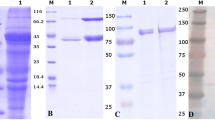Abstract
The intestinal mucus layer provides a potential niche for colonization by vancomycin-resistant Enterococcus faecium (VREF). We therefore examined the ability of six VREF strains to adhere to human intestinal mucus and determined binding kinetics. Four of six (67%) VREF strains demonstrated significant adhesion to immobilized intestinal mucus compared with a Salmonella typhimurium–negative control strain, but the level of adherence was low compared with Lactobacillus rhamnosus GG. Binding kinetics studies demonstrated that the maximum number of these four VREF strains that could adhere to a unit surface area of immobilized mucus was similar to or higher than the maximum number of L. rhamnosus GG that could adhere; however, L. rhamnosus GG demonstrated 20- to 130-times higher affinity than the VREF strains. These results demonstrate that VREF strains may adhere to human intestinal mucus and suggest that L. rhamnosus GG might be able to displace VREF strains.


Similar content being viewed by others
Literature Cited
Atuma C, Strugala V, Allen A, Holm L (2001) The adherent gastrointestinal mucus gel layer: Thickness and physical state in vivo. Am J Physiol Gastrointest Liver Physiol 280:G922–9
Cohen PS, Laux DC (1995) Bacterial adhesion to and penetration of intestinal mucus in vitro. Methods Enzymol 253:309–315
Donskey CJ, Schreiber JR, Jacobs MR, Shekar R, Salata RA, Gordon S, et al. (1999) A polyclonal outbreak of predominantly vanB vancomycin-resistant enterococci in Northeast Ohio. Clin Infect Dis 29:573–579
Freter R, Brickner H, Fekete J, Vickerman MM, Carey KE (1983) Survival and implantation of Escherichia coli in the intestinal tract. Infect Immun 39:686–703
Jin LZ, Marquardt RR, Zhao X (2000) A strain of Enterococcus faecium (18C23) inhibits adhesion of enterotoxigenic Escherichia coli K88 to porcine small intestine mucus. Appl Environ Microbiol 66:4200–4204
Laukova A, Strompfova V, Ouwehand A (2004) Adhesion properties of enterococci to intestinal mucus of different hosts. Vet Res Commun 28:647–655
Laux DC, Cohen PS, Conway T (2005) Role of the mucus layer in bacterial colonization of the intestine. In: Nataro JP, Cohen PS, Mobley HLT, Weiser JN (eds) Colonization of mucosal surfaces, vol. 1. Washington DC: ASM Press, pp 199–212
Lee YK, Lim CY, Teng WL, Ouwehand AC, Tuomola EM, Salminen S (2000) Quantitative approach in the study of adhesion of lactic acid bacteria to intestinal cells and their competition with enterobacteria. Appl Environ Microbiol 66:3692–3697
McCormick BA, Stocker BAD, Laux DC, Cohen PS (1988) Roles of motility, chemotaxis, and penetration through and growth in intestinal mucus in the ability of an avirulent strain of Salmonella typhimurium to colonize the large intestine of streptomycin-treated mice. Infect Immun 56:2209–2217
Ouwehand AC, Tuomola EM, Lee YK, Salminen S (2001) Microbial interactions to intestinal mucosal models. Methods Enzymol 337:200–212
Ouwehand AC, Salminen S, Roberts PJ, Ovaska J, Salminen E (2003) Disease-dependent adhesion of lactic acid bacteria to the human intestinal mucosa. Clin Diagn Lab Immunol 10:643–646
Pultz NJ, Stiefel U, Subramanyan S, Helfand MS, Donskey CJ (2005) Mechanisms by which the anaerobic microbiota inhibit the establishment of vancomycin-resistant Enterococcus intestinal colonization in mice. J Infect Dis 191:949–956
Rinkinen M, Westermarck E, Salminen S, Ouwehand AC (2003) Absence of host specificity for in vitro adhesion of probiotic lactic acid bacteria to intestinal mucus. Vet Microbiol 97:55–61
Vesterlund S, Paltta J, Karp M, Ouwehand AC (2005) Measurement of bacterial adhesion—In vitro evaluation of different methods. J Microbiol Methods 60:225–233
Wadolkowski EA, Laux DC, Cohen PS (1988) Colonization of the streptomycin-treated mouse large intestine by a human fecal Escherichia coli strain: Role of growth in mucus. Infect Immun 56:1030–1035
Wadolkowski EA, Laux DC, Cohen PS (1988) Colonization of the streptomycin-treated mouse large intestine by a human fecal Escherichia coli strain: Role of adhesion to mucosal receptors. Infect Immun 56:1030–1035
Acknowledgments
This work was supported by an Advanced Research Career Development Award from the Department of Veterans Affairs (C. J. D.) and by a research grant from the Academy of Finland (S. V.).
Author information
Authors and Affiliations
Corresponding author
Rights and permissions
About this article
Cite this article
Pultz, N.J., Vesterlund, S., Ouwehand, A.C. et al. Adhesion of Vancomycin-Resistant Enterococcus to Human Intestinal Mucus. Curr Microbiol 52, 221–224 (2006). https://doi.org/10.1007/s00284-005-0244-2
Received:
Accepted:
Published:
Issue Date:
DOI: https://doi.org/10.1007/s00284-005-0244-2




